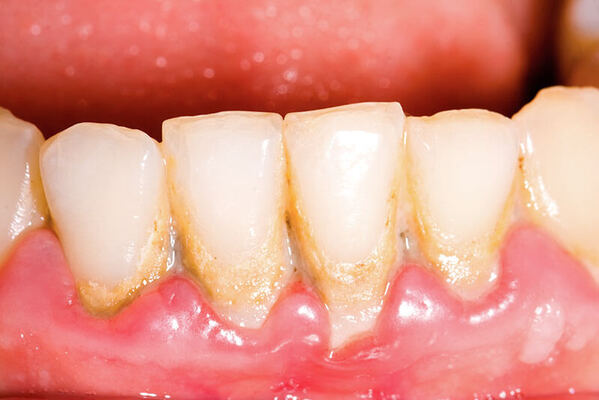What is Periodontal Disease?The word periodontal means “around the tooth.” Periodontal disease attacks the gums and the bone that supports the teeth. It is caused by plaque, which is a sticky film of food debris, bacteria, and saliva that builds up on teeth. If plaque is not removed, it turns into calculus (tartar). When plaque and calculus are not removed, they begin to destroy the gums and bone. Periodontal disease is characterized by red, swollen, and bleeding gums. Poor oral hygiene and smoking both increase the risk of periodontal disease.
Four out of five people who have periodontal disease don’t know it! Most people are not aware of it because the disease is usually painless in the early stages. Not only is it the number one reason for tooth loss, research suggests that there may be a link between periodontal disease and other diseases such as, stroke, bacterial pneumonia, diabetes, cardiovascular disease, and increased risk during pregnancy. |
|
Good oral hygiene, a balanced diet, and regular dental visits can help reduce your risk of developing periodontal disease.
|
Signs & Symptoms of Periodontal Disease
|
Diagnosis of Periodontal Disease
|
Periodontal disease is diagnosed by your dentist or dental hygienist during a periodontal examination. This type of exam should always be part of your regular dental check-up.
A periodontal probe (small dental instrument) is gently used to measure the sulcus (pocket or space) between the tooth and the gums. The depth of a healthy sulcus measures three millimeters or less and does not bleed. The periodontal probe helps indicate if pockets are deeper than three millimeters. As periodontal disease progresses, the pockets usually get deeper. Your dentist or hygienist will use pocket depths, amount of bleeding, inflammation, tooth mobility, etc., to make a diagnosis that will fall into a category below: Gingivitis Gingivitis is the first stage of periodontal disease. Plaque and its toxin by-products irritate the gums, making them tender, inflamed, and likely to bleed. Periodontitis Plaque hardens into calculus (tartar). As calculus and plaque continue to build up, the gums begin to recede from the teeth. Deeper pockets form between the gums and teeth and become filled with bacteria and pus. The gums become very irritated, inflamed, and bleed easily. Slight to moderate bone loss may be present. Advanced Periodontitis The teeth lose more support as the gums, bone, and periodontal ligament continue to be destroyed. Unless treated, the affected teeth will become very loose and may be lost. Generalized moderate to severe bone loss may be present. |
Request an AppointmentMt. Calvary Dental
Dr. Caitlin Biever, DDS 100 Evergreen Road Mt. Calvary, WI 53057 920-753-2771 Office Hours: Monday: 11:00 am - 7:00 pm Tues, Wed, Thurs: 7:00 am - 4:00 pm Friday: Closed |
Treatment of Periodontal Disease
|
Periodontal treatment methods depend upon the type and severity of the disease. Your dentist and dental hygienist will evaluate for periodontal disease and recommend the appropriate treatment.
Periodontal disease progresses as the sulcus (pocket or space) between the tooth and gums gets filled with bacteria, plaque, and tartar, causing irritation to the surrounding tissues. When these irritants remain in the pocket space, they can cause damage to the gums and eventually, the bone that supports the teeth. If the disease is caught in the early stages of gingivitis, and no damage has been done, one to two regular cleanings will be recommended. You will also be given instructions on improving your daily oral hygiene habits and having regular dental cleanings. |
If the disease has progressed to more advanced stages, a special periodontal cleaning called scaling and root planing (deep cleaning) will be recommended. It is usually done one quadrant of the mouth at a time while the area is numb. In this procedure, tartar, plaque, and toxins are removed from above and below the gum line (scaling) and rough spots on root surfaces are made smooth (planing). This procedure helps gum tissue to heal and pockets to shrink. Medications, special medicated mouth rinses, and an electric tooth brush may be recommended to help control infection and healing.
If the pockets do not heal after scaling and root planing, periodontal surgery may be needed to reduce pocket depths, making teeth easier to clean. Your dentist may also recommend that you see a Periodontist (specialist of the gums and supporting bone). |
Managing Periodontal Disease
|
|
Good oral hygiene and regular periodontal cleanings are essential in maintaining dental health and keeping periodontal disease under control.
|
From a delighted patient...
|
"...they work with you to ensure that you understand and are comfortable with the whole process..."
~Danielle B. 5-Star Google Review |







